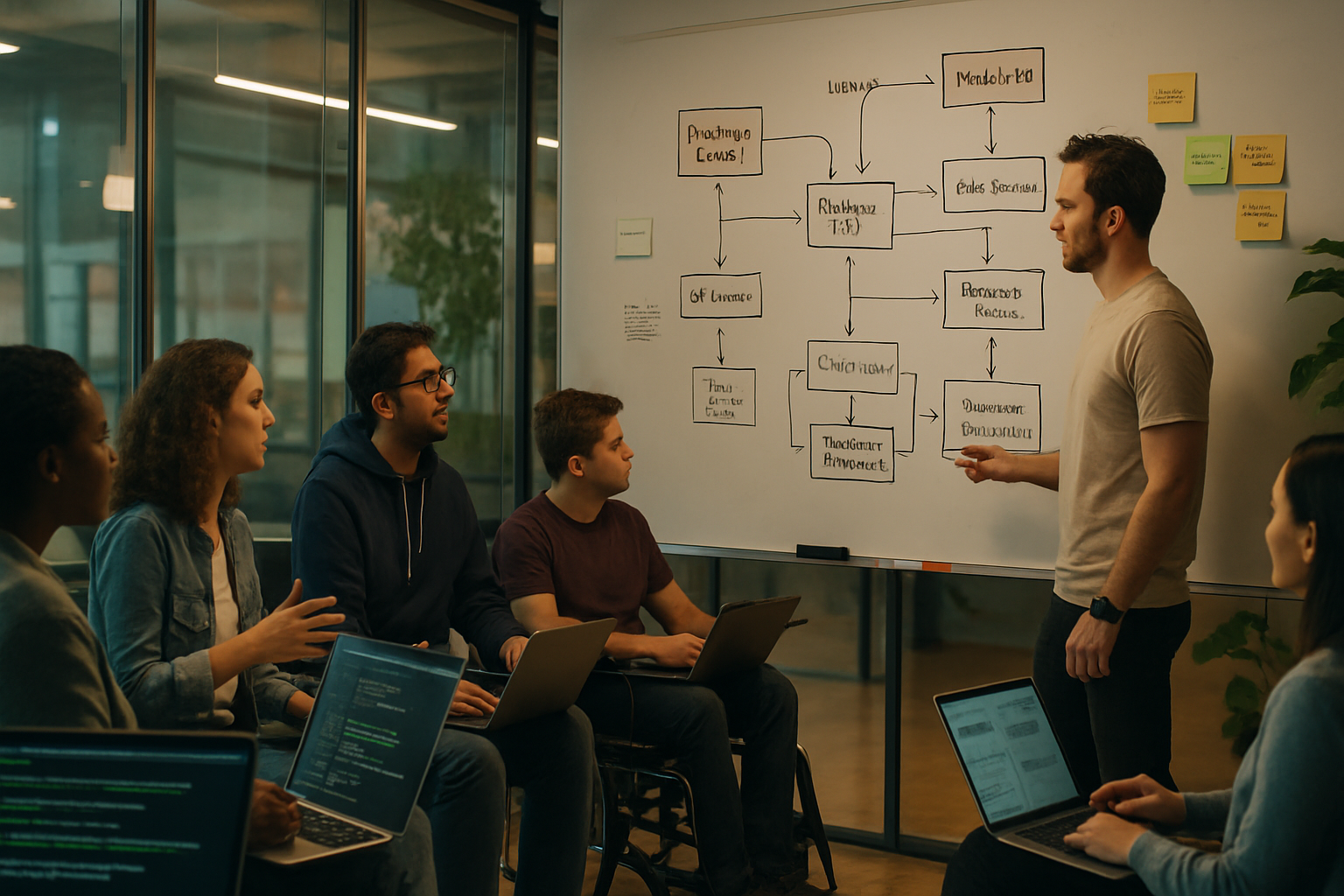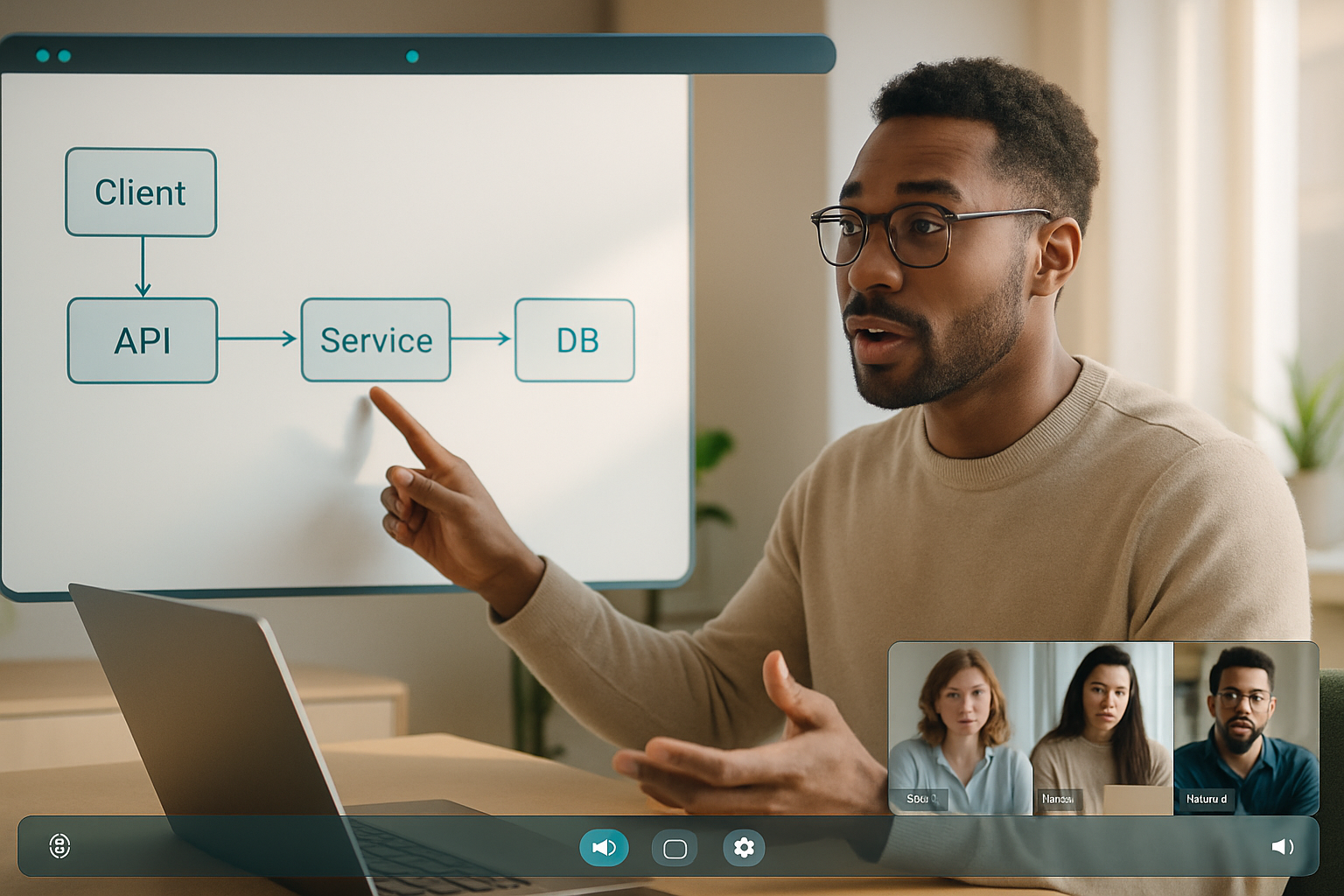· career · 6 min read
The Myth of the Perfect Solution: Rethinking Whiteboard Interview Expectations
Whiteboard interviews aren't a search for flawless code - they're an audition for how you think. Learn why showing your reasoning, trade-offs, and incremental progress matters more than a 'perfect' final answer, with a practical framework, examples, and recovery strategies.

Introduction
Whiteboard interviews have a reputation: arrive, write pristine code from memory, and leave with an offer. That reputation creates pressure to produce a “perfect” solution on first attempt. In reality, interviewers rarely expect perfection - they want to see how you think, communicate, evaluate trade-offs, and recover from mistakes.
This post explores the myth of the perfect solution, explains what interviewers are usually assessing, and gives a concrete, repeatable approach you can use to present your thinking clearly and confidently during whiteboard-style interviews.
Why the myth persists
- Online leaderboards, competitive coding sites, and interview folklore reward flawless answers and fast solutions. That conditions candidates to expect perfection.
- Interviewers often have a rubric and a checklist, but candidates don’t see it. Without transparency, it’s easy to assume any deviation from an elegant final answer is failure.
- Stress and time pressure amplify self-criticism: one small bug or forgotten edge case feels like a catastrophic failure when you’re nervous.
Why perfect code is not the point
Interviewers usually evaluate multiple signals, not just the final code:
- Problem understanding and clarifying questions - do you make good assumptions explicit?
- Problem decomposition and approach selection - can you explain alternatives and why you choose one?
- Correctness reasoning - do you articulate invariants, edge cases, and complexity?
- Incremental improvement - do you iterate from a simple working version to a better one?
- Communication and collaboration - can you speak clearly, accept hints, and adapt?
A clean, complete solution helps - but the path you take matters more.
A practical 5-step framework to show your thinking
This framework is short enough to remember under stress and maps to what interviewers want.
- Clarify and scope
- Ask questions: input types, bounds, allowed libraries, expected output forms, and performance constraints.
- Repeat back your understanding before you start.
- Outline approaches and trade-offs
- Offer 2–3 approaches (brute force, optimized, and an alternative) and briefly compare time/space cost and complexity of implementation.
- Explicitly say which you’ll implement and why.
- Start with a simple, correct baseline
- Implement a straightforward (even if suboptimal) solution or a clear brute-force approach in pseudocode.
- This gives you something testable and shows you can reach correctness.
- Iterate and optimize
- Explain how to improve complexity or memory use.
- Convert the baseline into the optimized approach step by step.
- At each step, describe invariants and why the transformation preserves correctness.
- Test, explain edge cases, and discuss trade-offs
- Walk through small examples, including edge cases.
- State complexity, possible failure modes, and real-world considerations (numerical stability, memory fragmentation, concurrency concerns, etc.).
A short worked example (two-pass -> one-pass)
Problem: Given an array of integers nums and a target, return indices of the two numbers such that they add up to target. Assume exactly one valid answer.
Rather than trying to “zip” to perfect hash-based code, show the path.
- Clarify
- Are numbers unique? (If not, is returning the same index twice allowed?)
- What are size limits? (n up to 10^5? 10^3?)
- Outline
- Brute-force: O(n^2) nested loops - easy to get correct.
- Two-pass hash map: O(n) time, O(n) space - build map, then search.
- One-pass hash map: O(n) time, O(n) space - search while building.
We’ll implement the two-pass approach first to be safe, then show the one-pass optimization.
- Baseline (pseudocode)
# two-pass approach (safe and easy to reason about)
hash = {}
for i, val in enumerate(nums):
hash[val] = i
for i, val in enumerate(nums):
complement = target - val
if complement in hash and hash[complement] != i:
return [i, hash[complement]]Explain: “This is easy to prove correct and runs in O(n) time with O(n) extra space. Now we can optimize to a single pass to be more space-efficient in practice (still O(n) space worst case but fewer passes).”
- Optimize to one-pass (step-by-step)
# one-pass: check complement while building map
hash = {}
for i, val in enumerate(nums):
complement = target - val
if complement in hash:
return [hash[complement], i]
hash[val] = iSpeak as you write: “If the complement exists already, we’ve found the earlier index; otherwise store the current value. We maintain the invariant that hash contains values seen so far.”
- Test and edge cases
- Example: nums = [2,7,11,15], target = 9 -> check steps and indices.
- Repeated numbers: nums = [3,3], target = 6 -> ensure we don’t reuse same index.
- Large n and possible integer overflow (language dependent) - mention if relevant.
This shows a path from a clear baseline to a refined solution, and it demonstrates correctness reasoning at each stage.
What to say out loud (sample scripts)
- Clarifying question: “Just to confirm, are we guaranteed exactly one solution and can I assume indices are zero-based?”
- Outlining approaches: “I see a brute-force O(n^2) approach, and an O(n) hash-table approach; I’ll start with the straightforward approach and optimize if we have time.”
- While coding: “I’m going to write the simple version first so we have a correct baseline, then I’ll explain how to make it faster.”
- If stuck: “I’m considering X and Y; I can try implementing X now and if it’s slow I can pivot to Y. Does that align with what you’d like to see?”
Why interviewers like this approach
- You demonstrate safety: a correct baseline reduces the chance that you’ll produce wrong-but-unclear code.
- You reduce risk: interviewers see logic even if you run out of time before full optimization.
- You reveal thinking: trade-offs and invariants tell interviewers how you’d reason about production problems.
Common mistakes and how to recover
- Silence: thinking silently for a long time looks like stall. Narrate your thinking.
- Jumping to code without clarifying assumptions: ask clarifying questions upfront.
- Obsessing over micro-optimizations too early: implement a correct solution first.
- Freezing when corrected: if an interviewer hints a bug, say “Good point - let me adjust my invariant” and apply it.
If you make a mistake:
- Acknowledge it quickly: “You’re right, that case fails when… I can fix it by…”
- Explain impact: “This bug would break the edge case where…; the fix is… and it doesn’t change complexity.”
- Implement the fix or describe it clearly if you’re out of time.
Beyond the whiteboard: collaboration and mindset
- Treat the interview like collaborative problem solving rather than performance art.
- Ask for and accept hints; sometimes interviewers are evaluating how you respond to guidance.
- Show humility and curiosity: say what you don’t know and how you’d learn it (e.g., testing methodology, library choices).
Practice routines that help you internalize the framework
- Solve problems with the explicit goal to narrate each decision - record yourself or practice with a peer.
- Time-box practice sessions: first 10 minutes for clarifying + approach, next 20 for baseline and iteration, last 10 for tests and trade-offs.
- Mock interviews where the interviewer interrupts with hints - practice integrating guidance.
Post-interview checklist
- If you ran out of time, verbally summarize what else you’d do: complexity improvements, robustness, tests.
- In follow-up communications (thank-you note), briefly reiterate a fix or optimization you ran out of time for - this demonstrates ownership.
Further reading
- Cracking the Coding Interview - a classic guide to interview patterns and practice problems: https://www.crackingthecodinginterview.com/
- interview.io blog - practical posts on debugging, pair-programming, and technical interviewing: https://interviewing.io/blog
- LeetCode Discussions - community solutions with multiple approaches and explanations: https://leetcode.com/discuss/
Final note: reframe the goal
The next time you step up to a whiteboard, reframe your objective: not to produce flawless code on the first try, but to make your thinking visible. A clear path from an understandable baseline to improved solutions, with transparent assumptions and tests, is far more convincing than a brittle, “perfect” one-shot answer. Interviewers want teammates, not magicians - show how you reason, communicate, and iterate, and you’ll be far more persuasive than trying to game the myth of perfection.



